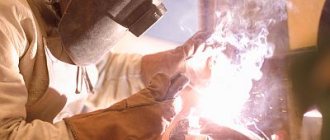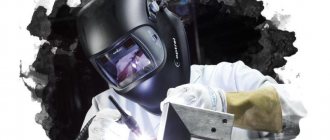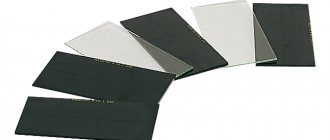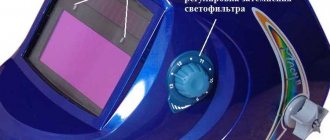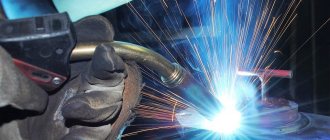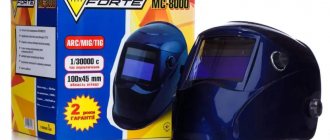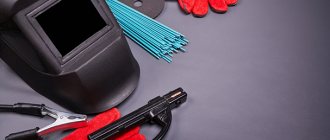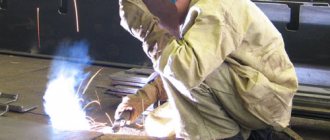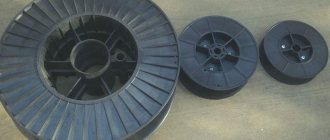The use of diopter lenses as auxiliary equipment for welding masks is not yet widely used today, but the idea of using a kind of magnifying glass to improve visibility and the quality of welded parts has been known for a long time.
Initially, the development of optical lenses for installation in a welding helmet was carried out with the aim of improving image quality and took place in parallel with the development of self-shading filters in chameleon masks. Progress in this direction over time has made it possible to expand several problems at once:
- equip welding helmets with additional lenses that improve visibility;
- develop lenses with varying degrees of convexity;
- extend the opportunity to work for professional welders, for whom vision is one of the main professionally necessary qualities.
Types of filters by purpose
Depending on the work, different types of filters are used. Glass for a welder's mask comes in several types depending on its purpose.
- Light filters for auxiliary workers during electric welding.
- For working with gas welding and cutting equipment.
- Light filters for electric welders.
For helpers, vision protection is provided by glasses with different shading, inserted into glasses.
When working with gas welding equipment, light filters made of tinted yellow-green glass with C6 shading are also used. They are fitted into safety glasses.
Light filters for working with electric welding have many degrees of protection, both from the bright radiation of the arc and from the ultraviolet and infrared spectra.
An important property of any welder’s protective glass is resistance to mechanical and thermal stress (slag fragments, splashes of molten metal).
Features of choice
If you are thinking about installing such a thing as glass for a welding helmet with diopters, then you should choose a really suitable model that would be useful to use. First of all, the choice depends on the mask. Lens manufacturers produce standard products, but some masks may have other sizes, which does not happen very often, but given the huge variety of manufacturers on the market, sometimes similar options come across. The lenses are attached from the inside, not from the outside, so the difference in size with the viewing window of the mask does not matter much, since the coincidence with the mounting location is sufficient.
"Important!
To install glass, you need a standard mask that has fastenings for such glass, otherwise installation may be impossible.”
The next parameter, which is no less important, is the number of diopters in the lens. The above standards are the most basic and broadest, as some manufacturers may have a larger step between model ratings or will not represent the full range. Welding glasses with diopters are selected depending on the degree of vision impairment, or for a specific type of work, if they are required only for magnification. To make it easier to decide, you should take the same value as on the glasses, with a slight rounding up. When working with small objects, it all depends on what type of welding is being done.
Magnifying lenses for welding helmets
Why use filters
When welding, the electric arc gives off a very bright glow that simply blinds a person. A flash of light of such intensity can cause burns to the surface of the eye (as welders say, catching a “bunny”), prolonged or frequent repetition of such glare leads to very painful irritation (“sand in the eyes”). If light of such strength constantly affects the cornea, it will lead to complete loss of vision. This is the first reason why protection is used when welding.
Also, without the use of light filters, it is impossible to simply control the welding process, and with sufficient darkness, you can clearly see what is happening in the weld pool.
During welding of parts by electric welding, other radiation is also released in the ultraviolet and infrared spectra. They, just like bright light, “harm” vision, although not as intensely.
And finally, splashes of molten metal and hot slag also pose a danger to the eyes.
Protective glass for masks differs mainly in the degree of darkening.
Diopter lenses for welding helmets
Diopter lenses help correct vision when performing welding work, without the need to wear a mask over glasses. Also, magnifying glasses are suitable for working with small objects for welders with normal vision.
The lenses are installed with the flat side facing the filter in the welding helmet, where a standard mount is provided for them. Made of optical polycarbonate 4 mm thick, plate size 108x50 mm. Available lenses with diopters: +1.00; +1.25; +1.50; +1.75; +2.00; +2.25; +2.5.
Lenses can be ordered from sales managers and official dealers in your region.
Article: 010.120.007 Diopter lens 250 (+2.5) Lens for vision correction, which allows the welder to carry out welding work without glasses. A 250 diopter lens has a magnification of +2.5 diopters. Made of optical polycarbonate 4 mm thick, plate size 108x50 mm. It is installed with the flat side facing the light filter in the welding helmet, where a standard lens mount is provided.
Price: RUR 1,020
Article: 010.120.006 Diopter lens 225 (+2.25)
A lens for correcting vision, which allows the welder to carry out welding work without glasses. A 225 diopter lens has a magnification of +2.25 diopters. Made of optical polycarbonate 4 mm thick, plate size 108x50 mm. It is installed with the flat side facing the light filter in the welding helmet, where a standard lens mount is provided.
Price: RUR 1,020
Article: 010.120.005 Diopter lens 200 (+2)
A lens for correcting vision, which allows the welder to carry out welding work without glasses. A 200 diopter lens has a magnification of +2 diopters. Made of optical polycarbonate 4 mm thick, plate size 108x50 mm. It is installed with the flat side facing the light filter in the welding helmet, where a standard lens mount is provided.
Price: RUR 1,020
Article: 010.120.004 Diopter lens 175 (+1.75)
A lens for correcting vision, which allows the welder to carry out welding work without glasses. The 175 diopter lens has a magnification of +1.75 diopters. Made of optical polycarbonate 4 mm thick, plate size 108x50 mm. It is installed with the flat side facing the light filter in the welding helmet, where a standard lens mount is provided.
Price: RUR 1,020
Article: 010.120.003 Diopter lens 150 (+1.5)
A lens for correcting vision, which allows the welder to carry out welding work without glasses. A 150 diopter lens has a magnification of +1.5 diopters. Made of optical polycarbonate 4 mm thick, plate size 108x50 mm. It is installed with the flat side facing the light filter in the welding helmet, where a standard lens mount is provided.
Price: 865 RUR
Article: 010.120.002 Diopter lens 125 (+1.25)
A lens for correcting vision, which allows the welder to carry out welding work without glasses. A 125 diopter lens has a magnification of +1.25 diopters. Made of optical polycarbonate 4 mm thick, plate size 108x50 mm. It is installed with the flat side facing the light filter in the welding helmet, where a standard lens mount is provided.
Price: RUR 1,020
Article: 010.120.001 Diopter lens 100 (+1)
A lens for correcting vision, which allows the welder to carry out welding work without glasses. A 100 diopter lens has a magnification of +1 diopter. Made of optical polycarbonate 4 mm thick, plate size 108x50 mm. It is installed with the flat side facing the light filter in the welding helmet, where a standard lens mount is provided.
Price: RUR 1,020
Types of light filters for electric welding
Today, two main types of filters are used for working with electric welding equipment and one special one.
- Constantly dimming filters.
- Filters with replaceable darkening (chameleon).
- Diopter lens for welding helmets.
VIEW Light filter for welding on AliExpress →
With constant dimming
Just 10 years ago, such protection was the only one in the arsenal of welders. Constantly darkening filters are made from glass with the addition of copper or nickel. This is done to reduce light transmission. Also, the outer surface can be mirrored to reflect rays.
The degree of darkness is the main indicator of a light filter. There are two classifications: Western (DIN) and domestic (C). The degrees are determined by the markings indicated directly on the filter.
Filters are selected depending on the current strength with which you will have to work. The higher the ampere, the darker the filter on the mask should be.
The positive qualities of permanently darkening filters are their low cost and durability.
With replaceable dimming
The main disadvantage of working with fixed-darkening filters is that you can’t see anything through them.
And in addition to the process of welding the metal itself, the welder needs to constantly inspect the seam, remove slag and clean the joint. To do this, you need to constantly remove the mask. To avoid such inconveniences, use automatic light filters for welding helmets - chameleons.
VIEW Automatic chameleon light filter on AliExpress →
Their operating principle is based on automatic darkening of the glass a few thousandths of a second before the arc ignites.
Chameleon is a complex system based on a liquid crystal screen. When the brightness (light voltage) changes, the crystals change their arrangement sequence, which reduces the light transmittance.
Chameleon protective glass can consist of 1-3 such screens, plus a protective screen that does not allow UV and IR radiation to pass through. And, of course, a layer of polymer that protects the system from splashes of molten metal.
Functionality is provided by an individual power supply powered by solar panels.
A mask with such filters allows you to carry out various manipulations, except for the welding process itself, without removing it. They are more expensive compared to fixed-tint safety glasses.
Diopter lenses
Such lenses are used for workers with vision problems, or when welding very small parts or thin sheet metal.
They allow you to enlarge the image for convenient control of the welding process.
As a rule, prescription lenses are produced in a universal size so that they can be installed on most protective masks.
The material for this type of glass is a special optical plastic, which is harmless to vision.
Lenses are selected individually, depending on your vision. Their maximum value is 3 diopters. They are installed in the middle of the protective mask.
Specifications
Manufacturers try to maintain uniform standards, which makes it possible to apply lenses to all masks without problems. This eliminates the problem of complex selection and incompatibility, as well as unnecessary waste of money. The unified standard for the manufacture of diopter glasses for a welding helmet is the following parameters:
- Thickness – 4 mm;
- Width – 108 mm;
- Height – 51 mm.
All products are manufactured in a rectangular shape, which does not necessarily coincide with the dimensions of the protective glass on the mask, but can be installed normally. The lens is inserted in front of the filter, so it is protected from splashes. It is easy to install and comes with several different diopter options. Here the choice is wider. As a rule, the maximum indicator contains 3 diopters and then everything goes down by 0.25 units:
- +3;
- +2,75;
- +2,5;
- +2,25;
- +2;
- +1,75;
- +1,5;
- +1,25;
- +1.
But here everything depends on the specific manufacturer, both the width of the range and the minimum spread between models. Almost all products are made from optical plastic, which easily and harmlessly copes with magnification functions, and is also practical for use in such conditions.
Lenses for welding helmets
